
Microwave is a form of electromagnetic radiation with wavelengths shorter than other radio waves but longer than infrared waves. Its wavelength ranges from about one meter to one millimeter, corresponding to frequencies between 300 MHz and 300 GHz, broadly construed. A more common definition in radio-frequency engineering is the range between 1 and 100 GHz, or between 1 and 3000 GHz . The prefix micro- in microwave is not meant to suggest a wavelength in the micrometer range; rather, it indicates that microwaves are small, compared to the radio waves used in prior radio technology.
Radio frequency (RF) is the oscillation rate of an alternating electric current or voltage or of a magnetic, electric or electromagnetic field or mechanical system in the frequency range from around 20 kHz to around 300 GHz. This is roughly between the upper limit of audio frequencies and the lower limit of infrared frequencies, and also encompasses the microwave range, though other definitions treat microwaves as a separate band from RF. These are the frequencies at which energy from an oscillating current can radiate off a conductor into space as radio waves, so they are used in radio technology, among other uses. Different sources specify different upper and lower bounds for the frequency range.

Microstrip is a type of electrical transmission line which can be fabricated with any technology where a conductor is separated from a ground plane by a dielectric layer known as "substrate". Microstrip lines are used to convey microwave-frequency signals.
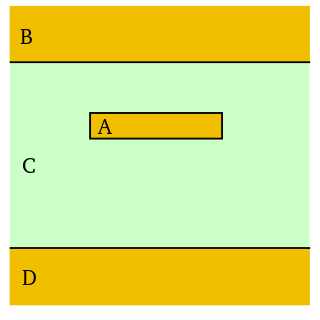
In electronics, stripline is a transverse electromagnetic (TEM) transmission line medium invented by Robert M. Barrett of the Air Force Cambridge Research Centre in the 1950s. Stripline is the earliest form of planar transmission line.
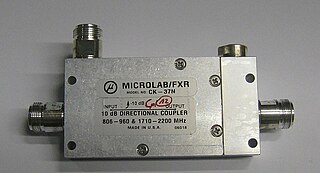
Power dividers and directional couplers are passive devices used mostly in the field of radio technology. They couple a defined amount of the electromagnetic power in a transmission line to a port enabling the signal to be used in another circuit. An essential feature of directional couplers is that they only couple power flowing in one direction. Power entering the output port is coupled to the isolated port but not to the coupled port. A directional coupler designed to split power equally between two ports is called a hybrid coupler.
RF microwave CAE CAD is computer-aided design (CAD) using computer technology to aid in the design, modeling, and simulation of an RF or microwave product. It is a visual and symbol-based method of communication whose conventions are particular to RF/microwave engineering.

Tatsuo Itoh was an electrical engineer who was professor and holder of the Northrop Grumman Chair in Microwave and Millimeter Wave Electronics in the Electrical Engineering Department at the University of California, Los Angeles (UCLA), where he taught and conducted research on microwave and millimeter wave electronics, guided wave structures, low power wireless electronics, and integrated passive components and antennas.
Jesse Eugene Russell is an American inventor. He was trained as an electrical engineer at Tennessee State University and Stanford University, and worked in the field of wireless communication for over 20 years. He holds patents and continues to invent and innovate in the emerging area of next generation broadband wireless networks, technologies and services, often referred to as 4G. Russell was inducted into the US National Academy of Engineering for his contributions to the field of wireless communication. He pioneered the field of digital cellular communication in the 1980s through the use of high power linear amplification and low bit rate voice encoding technologies and received a patent in 1992 for his work in the area of digital cellular base station design.
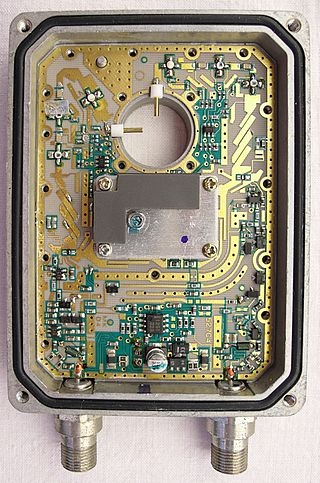
A distributed-element filter is an electronic filter in which capacitance, inductance, and resistance are not localised in discrete capacitors, inductors, and resistors as they are in conventional filters. Its purpose is to allow a range of signal frequencies to pass, but to block others. Conventional filters are constructed from inductors and capacitors, and the circuits so built are described by the lumped element model, which considers each element to be "lumped together" at one place. That model is conceptually simple, but it becomes increasingly unreliable as the frequency of the signal increases, or equivalently as the wavelength decreases. The distributed-element model applies at all frequencies, and is used in transmission-line theory; many distributed-element components are made of short lengths of transmission line. In the distributed view of circuits, the elements are distributed along the length of conductors and are inextricably mixed together. The filter design is usually concerned only with inductance and capacitance, but because of this mixing of elements they cannot be treated as separate "lumped" capacitors and inductors. There is no precise frequency above which distributed element filters must be used but they are especially associated with the microwave band.

Metamaterial antennas are a class of antennas which use metamaterials to increase performance of miniaturized antenna systems. Their purpose, as with any electromagnetic antenna, is to launch energy into free space. However, this class of antenna incorporates metamaterials, which are materials engineered with novel, often microscopic, structures to produce unusual physical properties. Antenna designs incorporating metamaterials can step-up the antenna's radiated power.

A waveguide filter is an electronic filter constructed with waveguide technology. Waveguides are hollow metal conduits inside which an electromagnetic wave may be transmitted. Filters are devices used to allow signals at some frequencies to pass, while others are rejected. Filters are a basic component of electronic engineering designs and have numerous applications. These include selection of signals and limitation of noise. Waveguide filters are most useful in the microwave band of frequencies, where they are a convenient size and have low loss. Examples of microwave filter use are found in satellite communications, telephone networks, and television broadcasting.
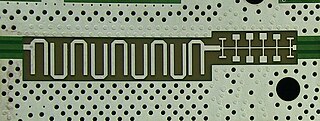
Planar transmission lines are transmission lines with conductors, or in some cases dielectric (insulating) strips, that are flat, ribbon-shaped lines. They are used to interconnect components on printed circuits and integrated circuits working at microwave frequencies because the planar type fits in well with the manufacturing methods for these components. Transmission lines are more than simply interconnections. With simple interconnections, the propagation of the electromagnetic wave along the wire is fast enough to be considered instantaneous, and the voltages at each end of the wire can be considered identical. If the wire is longer than a large fraction of a wavelength, these assumptions are no longer true and transmission line theory must be used instead. With transmission lines, the geometry of the line is precisely controlled so that its electrical behaviour is highly predictable. At lower frequencies, these considerations are only necessary for the cables connecting different pieces of equipment, but at microwave frequencies the distance at which transmission line theory becomes necessary is measured in millimetres. Hence, transmission lines are needed within circuits.
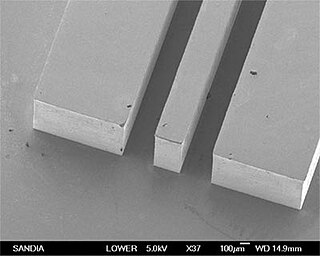
Coplanar waveguide is a type of electrical planar transmission line which can be fabricated using printed circuit board technology, and is used to convey microwave-frequency signals. On a smaller scale, coplanar waveguide transmission lines are also built into monolithic microwave integrated circuits.
Air stripline is a form of electrical planar transmission line whereby a conductor in the form of a thin metal strip is suspended between two ground planes. The idea is to make the dielectric essentially air. Mechanical support of the line may be a thin substrate, periodical insulated supports, or the device connectors and other electrical items.

Stepan Lucyszyn FREng, FIEEE is a British engineer, inventor and technologist, and has been a Professor of Millimetre-wave Systems at Imperial College London, England, since 2016. He was elevated to Fellow of the Institute of Electrical and Electronics Engineers (IEEE) in 2014 and elected to Fellow of the Royal Academy of Engineering (RAEng) in 2023. Lucyszyn's research has mainly focused on monolithic microwave integrated circuits (MMICs), radio frequency microelectromechnical systems, wireless power transfer (WPT), thermal infrared technologies and additive manufacturing.

Distributed-element circuits are electrical circuits composed of lengths of transmission lines or other distributed components. These circuits perform the same functions as conventional circuits composed of passive components, such as capacitors, inductors, and transformers. They are used mostly at microwave frequencies, where conventional components are difficult to implement.
Ahmadreza Rofougaran, also known as Reza Rofougaran is an Iranian-American Electrical engineer, inventor and entrepreneur.
Melvin M. Weiner was an electrical engineer, scientist, author, and inventor. He authored three books and 36 refereed papers. He was also the holder of five patents. He was the first to reduce pass-bands and stop-bands in photonic crystals to practice. Weiner was the founder-chairman of the Motor Vehicle Safety Group.
Yihong Qi is an engineer, professor, entrepreneur, and inventor. His work focuses on networking science and technology. Qi is currently an adjunct professor of Electrical and Computer Engineering at the Missouri University of Science and Technology. He is a Fellow of The Canadian Academy of Engineering and of the National Academy of Inventors. Qi's research has led to the founding of five independent companies.
Earl W. McCune Jr. was an American electrical engineer, telecommunications engineer, inventor, Silicon Valley entrepreneur, and IEEE Fellow. He is known for his research on achieving "Green" communications systems that have optimal energy efficiency.












